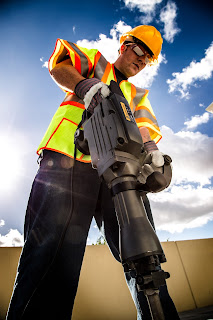This was a question posed to me by a new client, and a very understandable question at that. If a client has really low pain-tolerance, does that mean we need to ignore their pain level when treating them in order to make progress? If tolerance is high, are we doing more damage to them by pushing too hard without them being able to set proper limits? Again, if tolerance is low, is that person just being soft?
 |
| "I'm smiling. Are you smiling?" |
The quick answers: No, pain tolerance is not all in your head. No, you're not a wimp. And no, we are not risking going too hard or too soft with treatment and exercise because you're tolerance is higher or lower than the average person. I digress...
What Affects Tolerance?
There are too many things that affect pain tolerance to try and go in depth to them all. There is a slew of cultural differences when it comes to perception of pain which can be affected by age, sex, or race alone!
Psychological factors also affect this tolerance. Again, I'm not saying that the perception is all in one's head. Rather, certain aspects of one's psychology, such as perception of control, depression or anxiety, and expectations of pain can all cause physiological changes within the nervous system and propagate pain sensitivity.
Finally, looking at a more at the peripheral sites of pain within the body, the reactions occurring at the nerve endings, during inflammation responses, and communications between the immune system and nerve cells all affect pain sensitivity and can become more or less reactive, depending on a person's condition. It's complicated. I spent an entire night trying to make sense of the biochemistry of it in order to summarize it in my blog and ultimately had to give up. I promise that the science is there, though!
 |
| Need-to-know! |
The Affect on Treatment and Rehab
So with that being said, we circle back to the question about the effectiveness of rehab and treatment when pain sensitivity and tolerance are higher or lower. If pain is preventing us from massaging a muscle hard enough to make a change, where is the benefit? If a client is insisting to keep going harder when you're already, essentially, on top of them with all of your weight, are we not going to hurt them more?
Well, as I covered in the past, the system that these treatments target isn't the muscular one. When we massage, when we exercise, we're addressing the nervous system itself, and so we're doing the body a favour by working within those limits (or lack thereof) of sensitivity and pain tolerance.
 |
| To a limit. Please don't actually try to break someone's back because they asked you to.. |
With that being said, if someone is highly-sensitive and can only tolerate very light touch, then those are the means that we'll stay in. By treating or exercising within that high level of sensitivity, the goal is to try to reverse some of those physiological changes contributing to it in order to, gradually, decrease the sensitivity and allow the client to eventually be able to accept more pressure.
On the flipside, if someone is highly-tolerable to pain, then yes, the treatment does become a bit tougher and more aggressive to try and meet their needs, but you don't have to worry about causing damage. Like I've noted before, the amount of force you would require to actually deform or damage tissue would be roughly the equivalent of a steamroller.
 |
| Don't try this at home. |
Subscribe to the Weekly Updates
Do you like the content that you're reading? Sign up to receive the weekly blog update from Cain Exercise Rehab directly to your email!

No comments:
Post a Comment